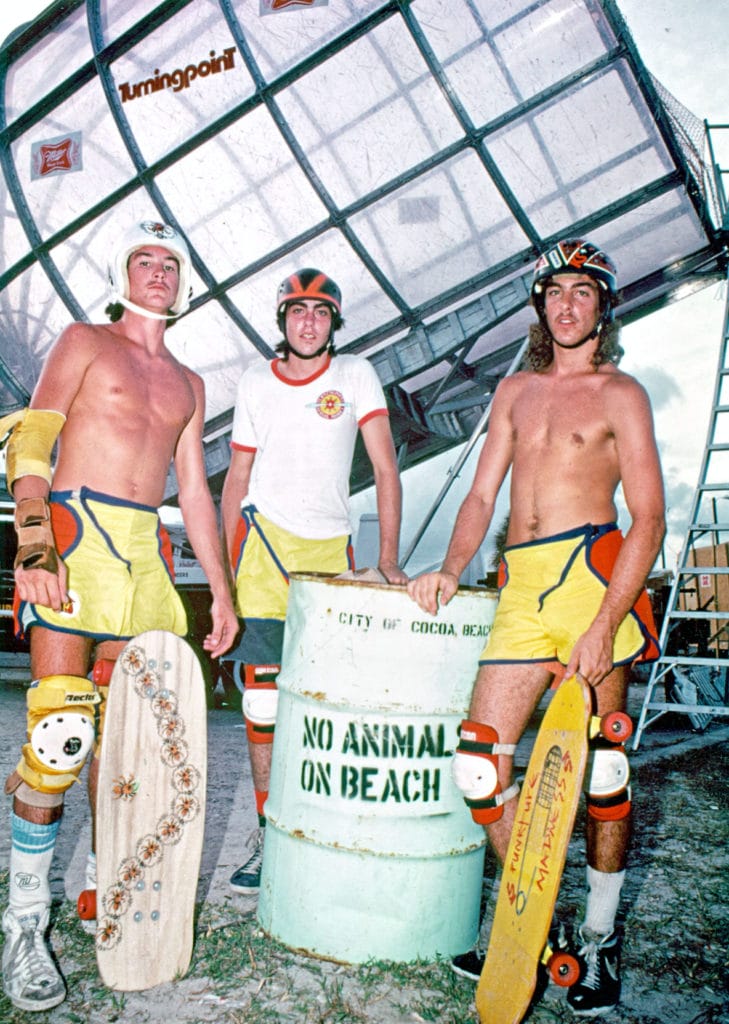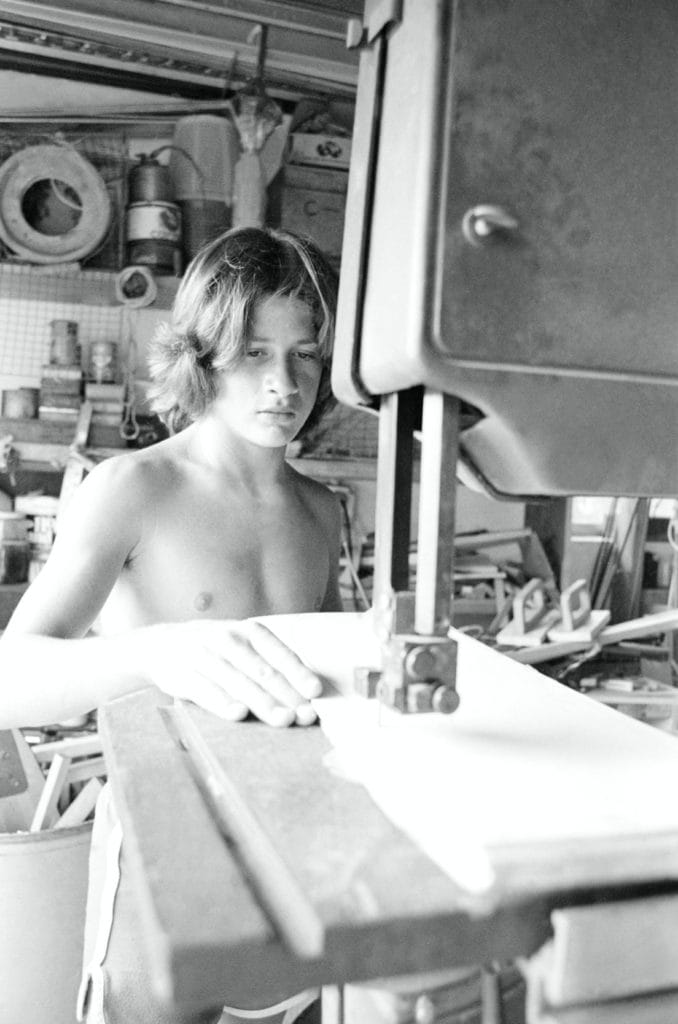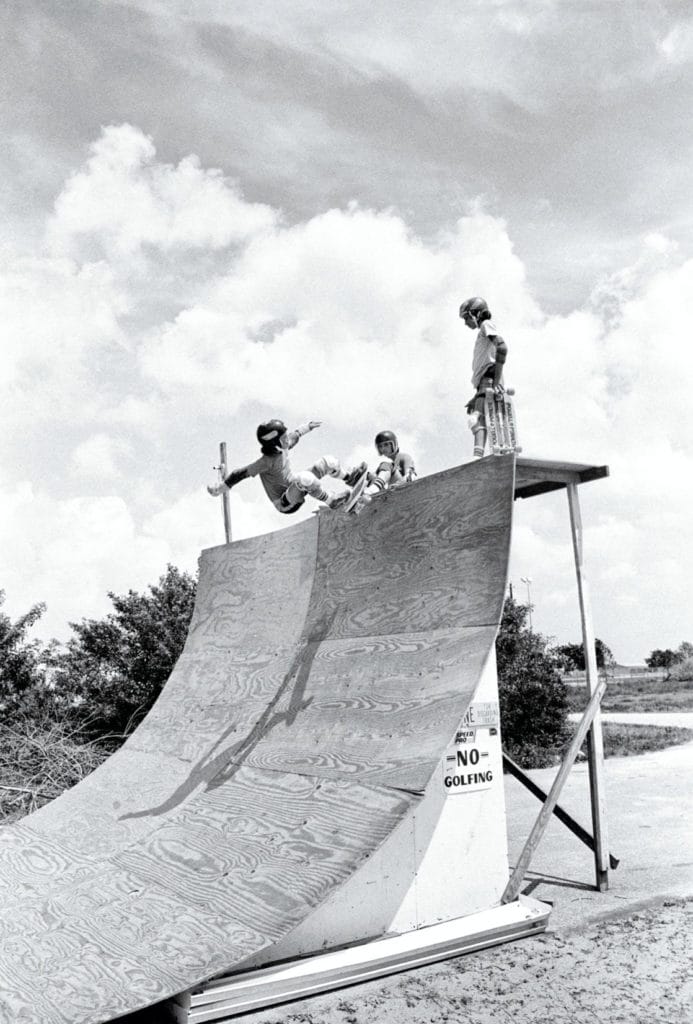Words and Photos by Craig B. Snyder
For all of its deviations, South Florida remains a place of transparency where greater diversity, equity and inclusion can thrive. No better example exists of that than the sport of skateboarding, an activity that was once considered to be practiced by wayward souls but has morphed into an official Olympic sport, debuting at the upcoming Tokyo Games. South Florida has been and continues to be a breeding ground for some of skateboarding’s biggest moments, evolving and furthering the sport here as much as anywhere else. We delve into the history of skateboarding’s impact on South Florida and South Florida’s impact on skateboarding.

(From left to right) Mike McGill, Diez, Brent Rademaker, Kevin Peterson and George McClellan watch Alan Gelfand skate at the Hollywood Ramp in 1979. This ramp, with its concrete swimming pool coping on one side and roll-out deck on the other, became the archetype of the vert ramps of the 1980s and beyond.
1900s-1960s: Pioneering Days
Skateboarding was a grassroots movement that began with children at play in urban centers, usually with a pair of cut-up roller skates and a plank of wood. This is contrary to the myths that skateboarding was invented in California or that it came from surfing—a narrative perpetuated by the mainstream media and the West Coast-based skateboard industry since the 1960s that continues to be sold to new generations of skateboarders.
The introduction of the steel-wheeled roller skate in the late 1800s and the advent of the first paved city streets around that same time led thrill-seeking children down a road of invention. Scooters, sometimes called scooter skates, were the first evolutionary form of the skateboard. They were made from a single roller skate split in two and attached to a plank of wood, with a crate and some handles added to the top for stability. In some cases, a more daring kid left the crate off, ending up with a bona fide “skateboard.”
One of the earliest skate pioneers rolled through South Florida in the 1940s. Lake Worth surf legend John “Chummer” McCranels (1938-2019) fabricated his first skateboard while a student at South Grade Elementary School. Ron Leiter, who hails from Florida’s central west coast, was another early skater. In the late 1950s, an 8-year-old Leiter assembled his first skateboard while he was a student at Pasadena Elementary School in St. Petersburg. According to Leiter, the skateboard was hand-me-down knowledge. “It was not unique to California,” he says.
In 1959, the first commercial skateboards hit the streets. The Roller Derby, made in Litchfield, Illinois, and the Skee-Skate, made in Culver City, California, were the first two brands to appear in retail outlets. Both were painted bright red with white lettering, the same color scheme as the Radio Flyer wagon that was popular with kids at the time.
In the early 1960s, as skateboarding experienced a boom, the first skateboarding contests were held. One of the earliest known U.S. competitions took place in South Florida. During the summer of 1964, the Riviera Beach Parks and Recreation Department held a “Skateboard Derby” on one of the city’s basketball courts. A local bank provided the trophies, and 47 boys and girls competed in three categories: an obstacle course, a timed race and a trick contest.
In 1965, just as the popularity of skateboarding seemed to be peaking, it crashed due to a combination of factors, including inferior design, negative coverage in the news media and citywide bans on skateboarding across parts of the country. Manufacturers were stuck with a glut of boards as the hype around skateboarding quickly died. But in the following decade, it would rise again.

In Cocoa Beach in 1979, 15-year-old Scott Senatore (center), who created the Turningpoint Ramp, is flanked by renowned professional skater Jimmy Plumer (left) of Jacksonville, and Senatore’s brother Kent (right), who set a world record by making the first 360-degree loops on a skateboard inside the clear Lexan full pipe earlier that year.
1970s: Urethane Revolution
By the 1970s, the influence of surfing on skateboarding helped it shift from a childhood pastime to a proper sport. The new skating style and its broad appeal helped make the Sunshine State one of the more important centers and incubators for the birth of modern skateboarding. Some of the significant skateboarding firsts that took place in Florida during the 1970s included parks, ramps and a variety of aerial maneuvers.
The revolution began in 1973 with the introduction of the first urethane skateboard wheel. This breakthrough technology took skateboarding to the next level and led to a causal sequence of innovation in skating and design. By 1975, a true skateboarding industry had been born, with over 150 manufacturers getting in on the action. Two full-length feature films released around that time, “Spinn’in Wheels” (USA) and “The Ultimate Flex Machine” (Australia), targeted young audiences and documented a new, intoxicating skate scene, adding more fuel to the fire.
Starting in the mid-1970s, a skate park building boom exploded across Florida. Before any opened in California, the first ’70s skate park in the country, Skateboard City, opened in Port Orange in February 1976 and was followed by Skateboard USA in Hollywood in March 1977—the first vertical skate park in the world. By 1978, a total of 31 skate parks had been constructed around the state. South Florida was home to eight of those: Skateboard Safari in West Palm Beach; Cadillac Wheels Skateboard Concourse in Pompano Beach; Skateboard Heaven, Solid Surf and Ride the Glass in Fort Lauderdale; Skateboard USA in Hollywood; and The Runway and Concrete Surf in Miami.

Seen here cutting shapes in his parents’ garage near North Lake in 1976, innovative freestyle skater and state champion Bobby Little of Hollywood was the name and personality behind Little Skateboards, one of the early board makers that came out of South Florida.
In these concrete playgrounds, a quest for air began. South Florida skaters, such as Alan “Ollie” Gelfand, Jeff Duerr, Pat Love, Jim McCall, Mike Folmer and Tab Textor, led the way. The Ollie, skateboarding’s most famous maneuver, was born in South Florida, although its parentage has been disputed.
Another sea change that took place in South Florida was the construction of the Hollywood Ramp in Pembroke Pines in 1978. Designed by Duerr and Kevin Peterson, this half-pipe became the archetype for the modern-day vert ramp. The first half-pipes in Florida and California in 1977 were impractical. They were narrow—only eight feet wide—and tight with no recovery space between the two sections. The Hollywood Ramp was revolutionary in its design because it was double-wide, had a flat bottom, incorporated a roll-out deck and set the standard in terms of radius and transition. In 1979, the Hollywood Ramp appeared on the cover of Skateboarder magazine, the sport’s bible in a pre-internet world. Almost overnight, it changed ramp design globally, and during the 1980s, “hollywoodramp” became a term in Germany and the Netherlands for a flat-bottom half-pipe.
Not far from the Hollywood Ramp, at a horse ranch in Davie, more groundbreaking feats took place. This was the secret location of an experimental, portable Lexan full pipe known as the Turningpoint Ramp. Designed by 15-year-old Scott Senatore and constructed by boat builder Ingram & Windler in Fort Lauderdale in 1978, the transparent Lexan ramp was where Senatore’s older brother, Kent, made the world’s first 360-degree loops on a skateboard in early 1979. In May 1979, the ramp made its public debut at Solid Surf skate park, where it received more media fanfare, including a feature in People magazine. The end cap, or cradle feature, of the Turningpoint Ramp is now a common element in modern skate parks.
From 1977 to 1979, South Florida was also a key shooting location for Hal Jepsen’s epic film “Skateboard Madness” (1980). Many of the events and skaters mentioned above are focal points in Jepsen’s magnum opus. One of the film’s more engaging moments is the slow-motion sequence with Dan Murray and Huck Andress, both from Boca Raton, jumping over a red Corvette in front of the prestigious Boca Raton Resort & Club.

Hailing from New Port Richey, McGill, who would go on to create the 540-degree McTwist in 1984, performs an Ollie Air on the Hollywood Ramp in 1979 as Diez and Gelfand watch from the roll-out deck.
1970s-Today: The Evolution
By the end of the 1970s, all the basic skateboarding maneuvers had been developed, as well as an entire range of equipment, including wheels, trucks and decks. Skate parks and ramps also played a huge part in the birth of modern skateboarding, as these environments became the petri dishes for most of the discovery and innovation that occurred. And if not for South Florida, no one knows how skateboarding would have unfolded in the decades that followed. Many early contributions by Florida skaters changed the sport forever.
Two South Florida skaters—Alex Sorgente of Lake Worth and Jamie Foy of Deerfield Beach—are currently making their mark on history as part of the USA Skateboarding National Team, which will send qualifying athletes to the Summer Olympics this year. And as the Tokyo Games inch closer, there’s no doubt a legion of South Florida fans will be cheering on these skaters; they are part of a region that has rewritten the sport’s narrative.
Originally appeared in the Summer 2021 issue.




